We need your consent to use the individual data so that you can see information about your interests, among other things. Click "OK" to give your consent.
ASTM D5592-94(2010)
Standard Guide for Material Properties Needed in Engineering Design Using Plastics
STANDARD published on 1.4.2010
The information about the standard:
Designation standards: ASTM D5592-94(2010)
Note: WITHDRAWN
Publication date standards: 1.4.2010
SKU: NS-31804
The number of pages: 6
Approximate weight : 18 g (0.04 lbs)
Country: American technical standard
Category: Technical standards ASTM
The category - similar standards:
Plastics in generalCharacteristics and design of machines, apparatus, equipment
Annotation of standard text ASTM D5592-94(2010) :
Keywords:
computer aided design (CAD), computer aided engineering (CAE), engineering design, finite element analysis, manufacturability, plastics, structural analysis, CAD/CAM systems, Computer aided design (CAD), Computer aided engineering (CAE), Engineering criteria/design, Finite element analysis, Manufacturability, Material properties, Structural design/engineering, Structural plastics, ICS Number Code 21.020 (Characteristics and design of machines, apparatus, equipment)
Additional information
| Significance and Use | ||||||||||||||||||||||||||||||||||||||||||
|
This guide is intended to serve as a reference to the plastics community for material properties needed in engineering design. Product datasheets or product literature typically report single-point values at ambient conditions and hence, by their very nature, are inadequate for engineering design and structural analysis of a component or system. A detailed property profile for the particular grade chosen for a given part not only enhances the confidence of the design engineer by allowing a more realistic assessment of the material under close-to-actual service environments but also may avoid premature failure of the designed component and potential liability litigation later. Additionally, it would also eliminate use of larger “design safety factors” that result in “overengineering” or “overdesign.” Not only is such overdesign unwarranted, but it adds to the total part cost, resulting in a good example of ineffective design with plastics and a prime target for substitution by other materials. One of the problems faced by design engineers is access to comparable data among similar products from different material suppliers because of the lack of standardized reporting format in the plastics industry. ISO 10350.1, ISO 11403-1, and ISO 11403-2 are intended to address the comparability of data issue only as far as single-point and multipoint data for material selection. This guide attempts to serve as a means to standardize the format to report comparable data for engineering design. It is essential that incorporating standardized test specimen geometry and specific test conditions as recommended in Guide D1999, Practice D3641, or ISO 3167 and ISO 294-1 are an integral part of the data generation. |
||||||||||||||||||||||||||||||||||||||||||
| 1. Scope | ||||||||||||||||||||||||||||||||||||||||||
|
1.1 This guide covers the essential material properties needed for designing with plastics. Its purpose is to raise the awareness of the plastics community regarding the specific considerations involved in using the appropriate material properties in design calculations. 1.2 This guide is intended only as a convenient resource for engineering design. It should be noted that the specific operating conditions (temperature, applied stress or strain, environment, etc. and corresponding duration of such exposures) could vary significantly from one application to another. It is, therefore, the responsibility of the user to perform any pertinent tests under actual conditions of use to determine the suitability of the material in the intended application. 1.3 The applicable ISO and ASTM standard methods for the relevant material properties are listed in this guide for the benefit of design engineers. 1.4 It should be noted that for some of the desired properties, no ASTM or ISO standards exist. These include pvT data, no-flow temperature, ejection temperature, and fatigue in tension. In these instances, relying on available test methods is suggested. 1.5 The values stated in SI units are to be regarded as standard. No other units of measurement are included in this standard. 1.6 This standard does not purport to address all of the safety concerns, if any, associated with its use. It is the responsibility of the user of this standard to establish appropriate safety and health practices and determine the applicability of regulatory limitations prior to use. Note 1—There is no similar or equivalent ISO standard. |
||||||||||||||||||||||||||||||||||||||||||
| 2. Referenced Documents | ||||||||||||||||||||||||||||||||||||||||||
|
Similar standards:
Historical
1.3.2007
Historical
15.5.2010
Historical
1.4.2011
Historical
15.5.2012
Historical
1.3.2007
Historical
1.9.2011
We recommend:
Technical standards updating
Do you want to make sure you use only the valid technical standards?
We can offer you a solution which will provide you a monthly overview concerning the updating of standards which you use.
Would you like to know more? Look at this page.


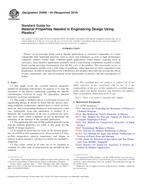
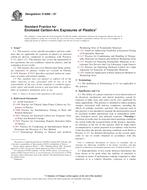 ASTM D6360-07
ASTM D6360-07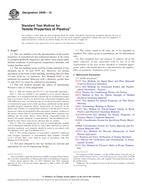 ASTM D638-10
ASTM D638-10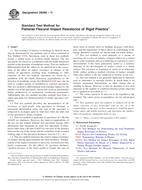 ASTM D6395-11
ASTM D6395-11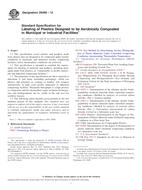 ASTM D6400-12
ASTM D6400-12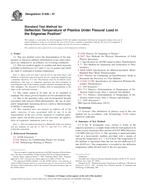 ASTM D648-07
ASTM D648-07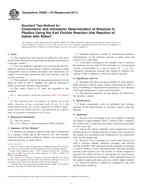 ASTM D6869-03(2011)..
ASTM D6869-03(2011)..
 Cookies
Cookies
